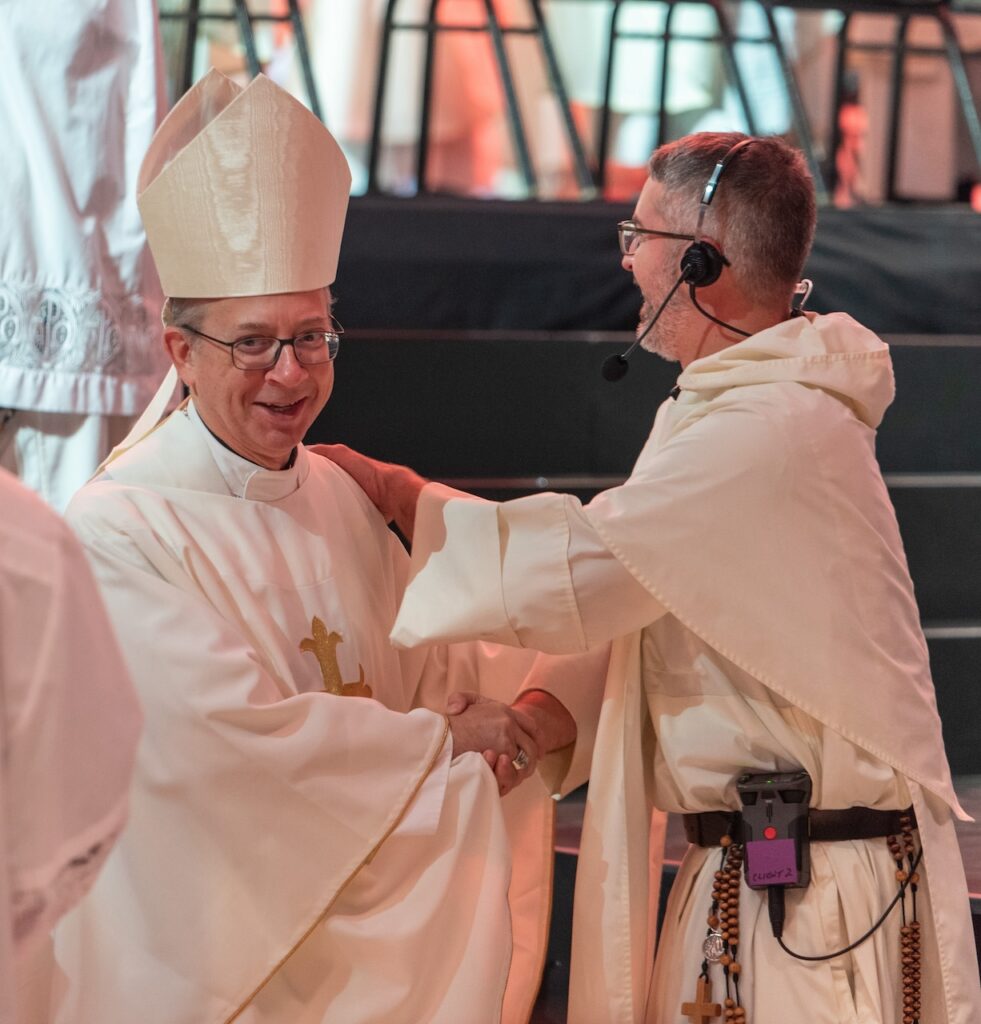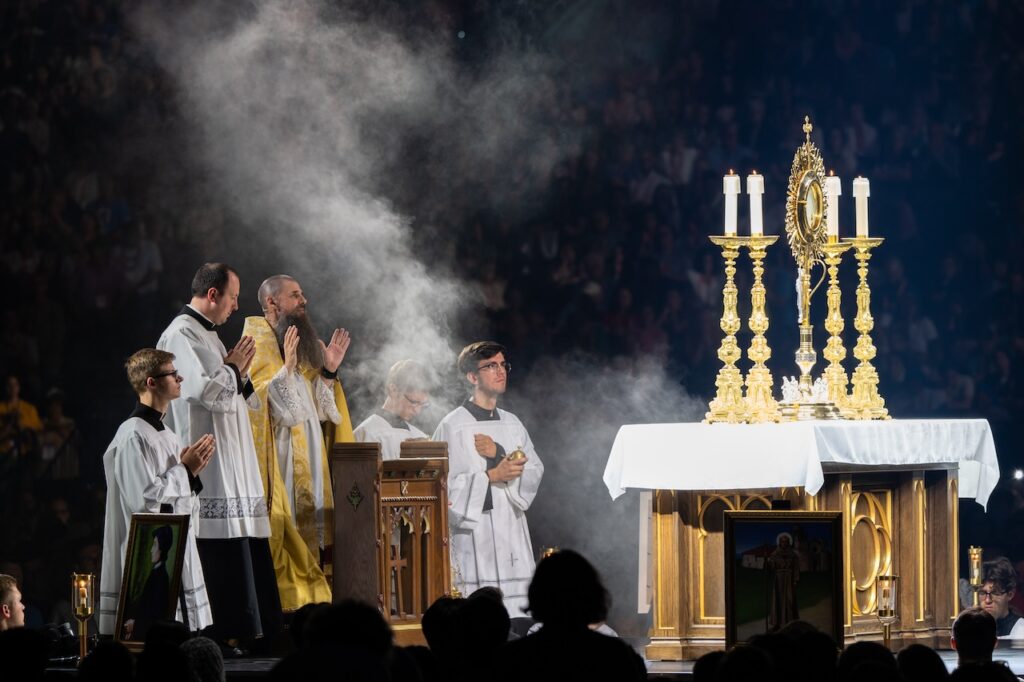Eighty-three years after the ninth National Eucharistic Congress, it was time for another revival.
From July 17-21, nearly 60,000 faithful traveled to Indianapolis for the 10th National Eucharistic Congress, the first such event since 1941.
Among them were 206 bishops and cardinals, 1,176 priests, 634 deacons, 1,236 religious brothers and sisters, and 614 seminarians. Adoration, processions, papal Masses, Eastern and ancient Latin rites, magnetic homilies, Catholic media stars, and a distinct lack of sleep defined the joyful gathering at Lucas Oil Stadium and the adjacent Indiana Convention Center.

“The word congress means ‘together walk,’” said Sister Josephine Garrett, Sister of the Holy Family of Nazareth, in a keynote speech July 19. “You are a repentant pilgrim, and the kingdom is coming.”
The stated goal of the event was to refocus the attention of the Church on the real presence of Christ in the Eucharist. According to a 2019 Pew Research survey, just 31% of American Catholics said they believe that “during Catholic Mass, the bread and wine actually become the body and blood of Jesus,” while 69% said they believe the bread and wine are “symbols.”
Jonathan Roumie, who stars as Jesus in the TV show “The Chosen,” wore a T-shirt during his keynote address offering Catholic writer Flannery O’Conner’s incendiary declaration on the matter: “If it’s just a symbol, to hell with it.”
Roumie used most of his time onstage July 20 to read the Bread of Life Discourse from the Gospel of John: “‘I am the living bread that came down from heaven; whoever eats this bread will live forever; and the bread that I will give is my flesh for the life of the world” (Jn 6:51).
“The Eucharist is medicine for our faith,” said Archbishop Gustavo García-Siller, who leads the Archdiocese of San Antonio, Texas. “It is medicine that sustains the mind, the life and the soul.”
Many parts, one body
Centered around the Eucharist, the Church gathered in Indianapolis as a unified body.
There were Masses in English, Spanish, Vietnamese, Latin and Greek, with translations available in 19 languages, and American Sign Language interpreters at each Mass. There were breakout talks in Spanish, breakout talks and Masses for families and youth, and low-gluten hosts at each Mass.
Adoration was held in different styles each night, ranging from Gregorian chants and silence, to litanies without music, to contemporary music performed by Catholic musician Matt Maher. In the morning, Father Rocky Hoffman led the Family Rosary Across America.
During Masses in English at Lucas Oil Stadium, a 36-person choir performed a mix of chants by St. Thomas Aquinas, traditional motets and hymns, Gospel songs and contemporary music. Under the leadership of Dave Moore, the strong voices and a piano wove the diverse styles into a seamless fabric of praise.
“There’s a real expression of the diversity of the Church [at the congress], but it feels unified,” said Sarah French, director of faith formation at St. Anne, Bristol. French traveled to the congress with her husband, Andrew, and her three young children.
“So often, the different groups in the Church are set against each other, but that’s not how it should be – we should all be together,” she said. “I’m impressed. It’s a hard thing to do.”
“There was no division,” said Father Chris Masla, administrator of Christ the King, Abingdon, and St. John, Marion, who attended the congress. “It was an experience of the whole Church united.”
Many of the faithful were struck by different concepts introduced by speakers at the daily revival sessions and breakout talks. Recognizable names included Father Mike Schmitz, the popular priest from Duluth, Minnesota, who hosts the “Bible in a Year” podcast, and Bishop Robert E. Barron, who leads the Diocese of Winona-Rochester, Minnesota, and founded the ministerial organization “Word on Fire.”
James Hammes, parishioner of Sacred Heart, Prince George, said that Sister Garrett’s call to “repent with courage and joy” was “a completely new concept to me.”

“[The congress] is the richest experience I’ve ever had in the Church, and I go to Mass all the time,” said Hammes. “And I think it will make Mass richer.”
Rey Dela Cruz, parishioner at St. Michael, Glen Allen, attended the Theology of the Eucharist breakout talk with fellow parishioners Alvin Ho, Rowen Igharas and Rosario Igharas. He was struck by the concept of the Old Testament being revealed in the New Testament.
“The priest says, ‘This is my body, this is my blood,’ in real time,” said Dela Cruz. “The body and blood of Christ is real and now.”
Scott Smith, another parishioner at Sacred Heart, Prince George, attended the congress with nine others from the Cluster Parishes of Sacred Heart; St. James, Hopewell; and St. John Nepomucene, Dinwiddie.
“I got to experience two things I’ve wanted to experience for a long time. One is a Christian concert. And the other is a really big Mass,” said Smith.
“I grew up Presbyterian, but since I converted in 2004, I’m falling in love more and more with the Catholic Church,” he added.
Deacon Bob Straub, who serves at Sacred Heart, compared the event to major pilgrimages he’s made around the world.
“I’ve been to Lourdes, Fátima, and Medjugorje, but those are not focused like this is focused,” said Deacon Straub.

In the afternoons, Deacon Straub attended breakout talks on liturgy, including “Biblical Roots of the Mass,” and “Unlocking the Eucharist.”
“It’s been very informative,” said Deacon Straub. “I’ve definitely got lots of homily material.”
Like Deacon Straub, Chris Spilka, director of campus ministry at Virginia Commonwealth University, said that he was excited to share what he’d learned with his community.
“One of the greatest blessings as a campus minister is to be able to see the power of the Eucharist, and to go forth and bring that to our college campuses,” he said.
“It’s our job when we go back, not just to focus on the knowledge of what the Eucharist is, but to get caught up in the love that God gives us through the Eucharist, through his body and blood, that he gave us this precious gift,” Spilka said.
Father Cassidy Stinson, administrator of St. Jude, Christiansburg, said, “It’s really exciting to be with so many people here to celebrate our Lord. It’s especially exciting for me to be with so many brother priests and bishops.”
“I’m excited to bring back a lot of fruits of the Congress – and the energy,” said Father Stinson.

On July 20, brothers and sisters in habit, seminarians, deacons, priests, abbots, bishops and cardinals led the Eucharist in a procession on a RAM 1500 pick-up truck through the streets of downtown Indianapolis.
“That moment felt like a victory march,” said Father Masla. “It was a reminder that the battle has been won, that Jesus Christ is risen and is with us. It was a time to celebrate, to be joyful, to sing his praises.”
‘Go and share’ the Gospel
On Sunday, July 21, Luis Antonio Cardinal Tagle, the special envoy appointed by Pope Francis to the National Eucharistic Congress and pro-prefect of the Dicastery for Evangelization’s Section for First Evangelization, was the main celebrant at Mass.
Cardinal Tagle greeted the congregation in English, Spanish, Italian, French, Portuguese, Vietnamese, Chinese, Malayalam, Swahili and Tagalog. The powerful choir was enhanced by a visit from the Indianapolis Symphony Orchestra, which played strings on classic hymns like Mozart’s “Ave verum corpus.”
“What you have heard, touched and tasted, go and share with others,” Cardinal Tagle said in his homily. “We must proclaim Jesus joyfully and zealously for the life of the world.”
Bishop Andrew H. Cozzens, of the Diocese of Crookston, Minnesota, who served as the board chair of the congress, gave a blessing and commissioning at the end of Mass. He also announced that the 11th National Eucharistic Congress will be held in the Year of Mercy, 2033, marking 2,000 years since the death and resurrection of Christ.
In his homily during the Syro-Malabar rite July 20, Archbishop Borys Gudziak, who leads the Ukrainian Catholic Archeparchy of Philadelphia, spoke about the potential of the congress and the faithful to change the world.
“The Church is young. It’s only 2000 years old,” said Archbishop Gudziak. “The universe has billions of years. Just think, 20,000 years from now, somebody might say – if we get it right, if we receive the spirit – ‘At the end of early, primitive Christianity, around the year 2000, things really started to get going.’”
See more photos of the congress.

